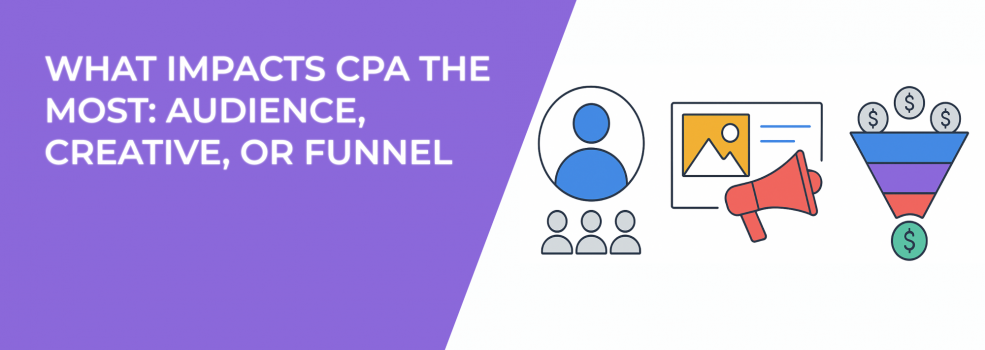Cost per acquisition (CPA) is one of those numbers that makes or breaks a campaign. If it’s too high, profitability slips. If it’s under control, scaling feels effortless. But what really drives CPA down? Is it the audience you target, the creative you put in front of them, or the funnel you guide them through?
Let’s break it down piece by piece.
Audience: The Foundation of Your CPA
Every advertiser knows targeting matters. But few realize how much a mismatched audience can inflate CPA — even when the creative looks great.
Imagine showing an ad for high-end software to a broad group of people who don’t even run businesses. They might click out of curiosity, but the chance of conversion? Almost zero. That’s wasted spend.
When you dial in your audience, CPA begins to drop. Why? Because:
-
Relevant people click with stronger intent.
-
Fewer impressions are wasted on the wrong eyes.
-
Retargeting pools fill with qualified leads rather than random traffic.
Practical tip: Test different audience depths. A narrow interest group may cost more per click, but conversions usually offset it. Meanwhile, broad targeting with strong creative can sometimes surprise you. The key is balance. Ask yourself: are you prioritizing reach, or are you prioritizing intent?
If you’re not sure how to layer and refine your targeting, check out How to Layer Detailed Targeting for Hyper-Specific Facebook Audiences and Audience Quality vs Quantity: What Drives Better Long-Term Results?.
Creative: The CPA Shifter
Even the perfect audience ignores bad creative. If the ad doesn’t capture attention, scroll happens — and clicks don’t. That’s why creative often acts as the immediate lever on CPA.
Think of creative as the “first handshake” between your brand and the user. A weak one feels forgettable. A strong one makes someone stop, consider, and engage.
Strong creative usually means:
-
Clear messaging that matches the audience’s problem.
-
Visuals that cut through busy feeds.
-
A call-to-action that feels natural instead of forced.
Hypothetical example: You’re running a campaign for a fitness coaching program. A generic stock photo ad saying “Get Fit Now” struggles. A real, well-shot before-and-after sequence with a short testimonial line? Suddenly, the same audience responds at half the CPA.
Want to sharpen your approach here? See Beginner’s Guide To Creative Testing and Ad Creative for Scroll-Stoppers: How to Design for Fast-Thumb Users.
The takeaway: creative doesn’t just affect CTR — it shapes conversion likelihood before users even hit the landing page.
Funnel: The Silent Multiplier
Audience and creative bring people in, but the funnel determines whether they actually convert. A messy funnel with too many steps inflates CPA no matter how well the other pieces work.
Consider a funnel with a long form, vague copy, and hidden pricing. Even interested users drop off. Compare that with a clear landing page, trust signals, and an easy signup path. The second funnel usually wins at a lower CPA — without changing the audience or ad creative at all.
Think about these funnel questions:
-
Is the value proposition instantly clear?
-
Do users trust you enough to submit their information?
-
Is the next step obvious, or are they left guessing?
A simple tweak — like moving testimonials higher on the page or reducing unnecessary form fields — can shave significant costs off acquisition.
If funnels are your weak point, you’ll get value from Facebook Ads Funnel Strategy: From Audience Identification to Conversion and Funnel Drop-Off Fixes: How to Improve Each Stage with Facebook Ad Data.
Which Factor Matters Most?
So what impacts CPA the most? The truth is that all three work in tandem. The wrong audience makes creative irrelevant. Weak creative makes even a strong funnel feel empty. A broken funnel wastes the best clicks you’ve ever paid for.
That said, prioritization helps:
-
Start with audience quality. Without it, nothing else holds.
-
Optimize creative next. It shapes the cost of entry.
-
Refine the funnel last. That’s where cost per acquisition gets locked in.
Marketers who treat CPA like a three-legged stool — audience, creative, funnel — tend to see the most stability. When one leg wobbles, the whole structure suffers.
Final Thoughts
Lowering CPA isn’t about chasing hacks or shortcuts. It’s about understanding the chain of influence. The right audience feeds strong creative. Strong creative drives people into a clear funnel. Each part multiplies the other.
So, ask yourself: is your CPA problem coming from the people you’re reaching, the story you’re telling, or the path you’ve built for them? Answering that honestly is the first step to cutting acquisition costs and scaling campaigns with confidence.

